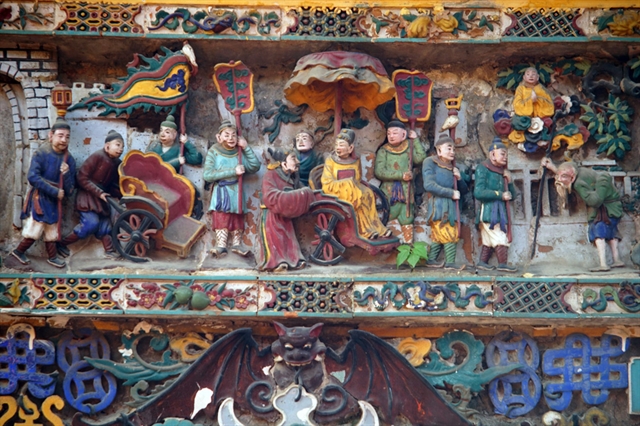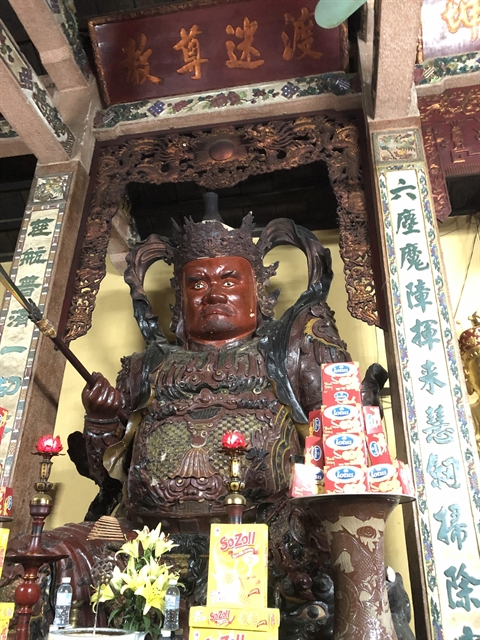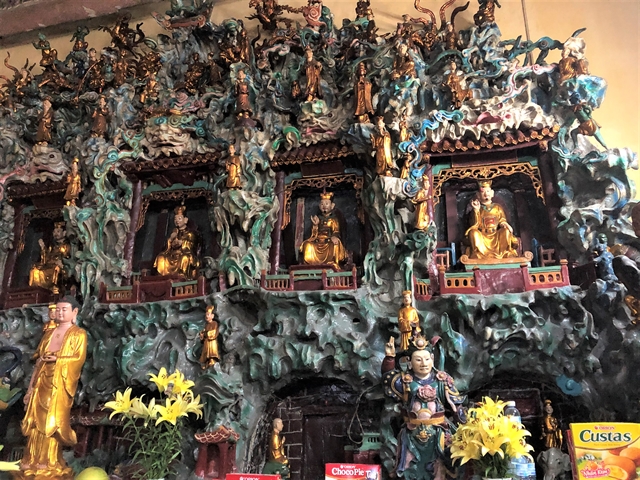 Sunday/Weekend
Sunday/Weekend

 |
| VIVID DETAIL: Scenes of social activities during ancient times are featured on decorative ceramics at Hưng Ký Pagoda. Photo phatgiao.org.vn |
Hưng Ký Pagoda, a much-loved cultural and spiritual heritage, has preserved many unique ceramic architectural artworks of the early 20th century.
The pagoda, located on an area of 3,000sq.m in Hà Nội's Hai Bà Trưng District, retains a large number of multi-colour glazed ceramics that have been mounted on various architectural elements, describing many stories in Buddhism.
The ancient beauty, special decorations and statues at the pagoda surprise many visitors, showcasing the talent and skill of Vietnamese artisans in the early 20th century.
Architectural works of Hưng Ký Pagoda, such as the three-arch entrance gate, Triratna Hall, Buddha Hall and the ancestral house, are arranged conveniently for Buddhists to come for daily worship.
On the arch of the inner gate, there is an inscription of four ancient Vietnamese ideographic words "Thị Nhân Giác Độ” (Show People Enlightenment).
Although the two sides of the alley leading to the pagoda have now been encroached on by local residential houses, it is easy to recognise its three-arch entrance or the main gate since it emerges with ancient decorative images of different animals, including elephants, horses and tigers. On top of the gate is a magnificent steeple where a big bell often rings on full-moon days or special Buddhist occasions.
The pagoda gate consists of two floors and eight roofs, with the upper floor as the steeple. The main gate has four pillars adorned with symbols of four supernatural creatures (the dragon, kylin, tortoise, and phoenix). Two outer sides of the gate are embossed with images of elephants and horses.
Passing through the front yard, we reach the Buddhist trinity altar and the Buddha Hall. The pagoda roof is shingled with tube tiles, and the two ends are attached with the ancient Vietnamese ideographic word "Thọ" (Longevity). In the middle of the roof, there is a bottle containing holy water. The collar beam is decorated with themes related to a classical Chinese story, Journey to the West.
 |
| ICON: There are not many statues in Hưng Ký Pagoda, but each is huge. VNS Photo Mai Phương |
The Triratna building has seven compartments with 12 main columns. Each column is 7m high and 30cm in diameter. In the middle of the Buddha Hall is a statue of Amitabha placed on a lotus in a meditating position. On the two gables of the hall are the two figures of Diêm Vương (King of Hell) made from fired and glazed clay by artisans of the Bát Tràng ceramics village.
All the hall's rafters, columns and beams are of reinforced concrete, with the outside covered by a light pink granite layer. The roof of the pagoda is covered with ceramic tiles. In contrast, the main altar's front roof is made of wood, with the outside covered by colourful glazed ceramics decorated with Bodhi leaves and in each leaf is an image of four-petal lime flowers.
"Through the decorative patterns on the doors, couplets and reliefs, the talent and sophistication of the potters are shown. The architecture of the pagoda has been preserved until now by generations of abbots,” Thích Từ Ân, abbot nun of Hưng Ký Pagoda, said.
Behind the Buddha Hall is a square memorial stela hall with four pillars and two roofs. On the beam between the upper and lower roofs are reliefs of scenes of Tang Seng, the main character in Journey to the West, going to find ancient Buddhist prayer book.
In the lower part of the roof are continuous reliefs of scenes of Sakyamuni Buddha attaining enlightenment and Quan Âm Thị Kính, the Vietnamese folk tale. The stela is made of 2.7m solid stone decorated with lotus flowers.
There are not many Buddha statues in Hưng Ký Pagoda, but each is large. In the middle of the Buddha Hall is the 3.86m-high statue of Amitabha Buddha. It reaches over 5m in height on a 1.3m pedestal.
The pagoda was built between 1931-1934 by Trần Văn Thành (alias Hưng Ký) and his wife VũThi Sáu, who were successful entrepreneurs in trading and making bricks and tiles. Thành was the owner of a brick factory by the Đuống River.
Thành had a keen business mind and absorbed advanced technology, so his bricks and tiles were favoured by domestic customers. At a trade fair held in Marseille, France, his products were awarded medals and cash prize. The businessman spent all the prize money and a lot of his business profit to build the pagoda and named it Hưng Ký.
 |
| STRANGE BEASTS: A special ceramic decorative structure on the roof of the main hall of Hưng Ký Pagoda. Photo phatgiao.org.vn |
To prepare for the construction, he and his employees, many local artisans, spent five years producing decorative ceramics and other materials. After finishing the pagoda, he also bought more land in Hoàng Mai and Tương Mai villages to expand the pagoda.
The stele in the pagoda was engraved with his words, stating his wish that the pagoda was built for Buddhism practice. He devoted all of his property to the pagoda and invited Buddhist monks and nuns to manage and preserve it.
The engraved words state: "For these ponds, houses, and lands, any monks who take care of the pagoda must look after them too. Offer flowers and burn incense to worship Buddha and Gods. The property should not be transferred to anyone. Even my children and grandchildren cannot claim it back."
The pagoda’s history and the property left by Hưng Ký are recorded on the stele. Every day, the pagoda welcomes Buddhist followers coming for religious practice.
“The pagoda is located in the south of the city centre, so it’s convenient for Buddhist followers to visit and worship. This is also the place where many other locals and I participate in ceremonies to pray for peace, wisdom and diligence and spread positive values in Buddha’s teachings,” said Mai Ánh Dương, a local Buddhist follower.
"I usually come to worship at Hưng Ký Pagoda at about 8pm every day. As a Buddhist, I have visited many pagodas in the country, many of which are newly built. However, for me, I find Hưng Ký the only one which still preserves the old style architecture that I admire so much." VNS
 |
| ORNATE: Part of the worshipping area in the Buddha Hall at Hưng Ký Pagoda. VNS Photo Mai Phương |